VOLVO XC90 2015 Workshop Manual
Manufacturer: VOLVO, Model Year: 2015, Model line: XC90, Model: VOLVO XC90 2015Pages: 570, PDF Size: 12.44 MB
Page 51 of 570
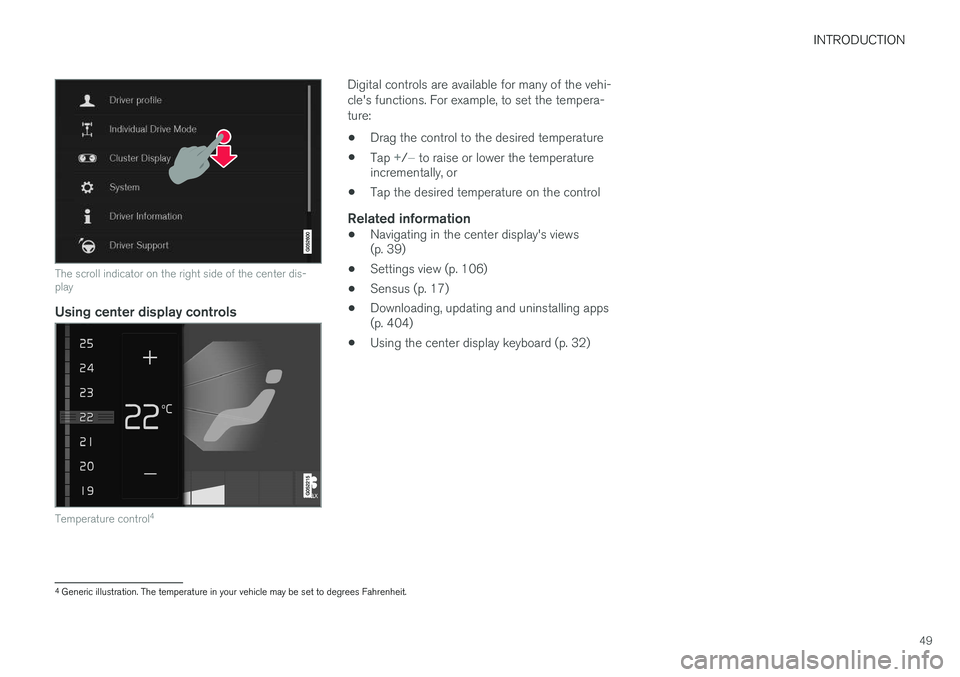
INTRODUCTION
49
The scroll indicator on the right side of the center dis- play
Using center display controls
Temperature control4
Digital controls are available for many of the vehi- cle's functions. For example, to set the tempera-ture:
• Drag the control to the desired temperature
• Tap
+/− to raise or lower the temperature
incrementally, or
• Tap the desired temperature on the control
Related information
• Navigating in the center display's views (p. 39)
• Settings view (p. 106)
• Sensus (p. 17)
• Downloading, updating and uninstalling apps(p. 404)
• Using the center display keyboard (p. 32)
4
Generic illustration. The temperature in your vehicle may be set to degrees Fahrenheit.
Page 52 of 570
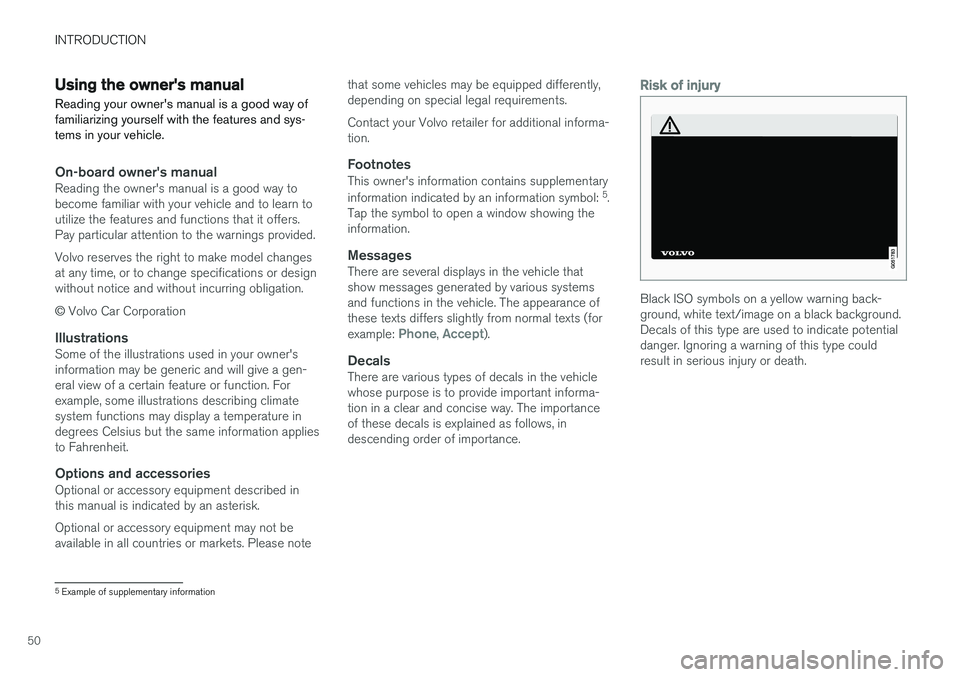
INTRODUCTION
50
Using the owner's manualReading your owner's manual is a good way of familiarizing yourself with the features and sys-tems in your vehicle.
On-board owner's manualReading the owner's manual is a good way to become familiar with your vehicle and to learn toutilize the features and functions that it offers.Pay particular attention to the warnings provided. Volvo reserves the right to make model changes at any time, or to change specifications or designwithout notice and without incurring obligation. © Volvo Car Corporation
IllustrationsSome of the illustrations used in your owner's information may be generic and will give a gen-eral view of a certain feature or function. Forexample, some illustrations describing climatesystem functions may display a temperature indegrees Celsius but the same information appliesto Fahrenheit.
Options and accessoriesOptional or accessory equipment described inthis manual is indicated by an asterisk. Optional or accessory equipment may not be available in all countries or markets. Please note that some vehicles may be equipped differently,depending on special legal requirements. Contact your Volvo retailer for additional informa- tion.
FootnotesThis owner's information contains supplementary information indicated by an information symbol:
5
.
Tap the symbol to open a window showing the information.
MessagesThere are several displays in the vehicle thatshow messages generated by various systemsand functions in the vehicle. The appearance ofthese texts differs slightly from normal texts (for example:
Phone, Accept).
DecalsThere are various types of decals in the vehicle whose purpose is to provide important informa-tion in a clear and concise way. The importanceof these decals is explained as follows, indescending order of importance.
Risk of injury
Black ISO symbols on a yellow warning back- ground, white text/image on a black background.Decals of this type are used to indicate potentialdanger. Ignoring a warning of this type couldresult in serious injury or death.
5 Example of supplementary information
Page 53 of 570
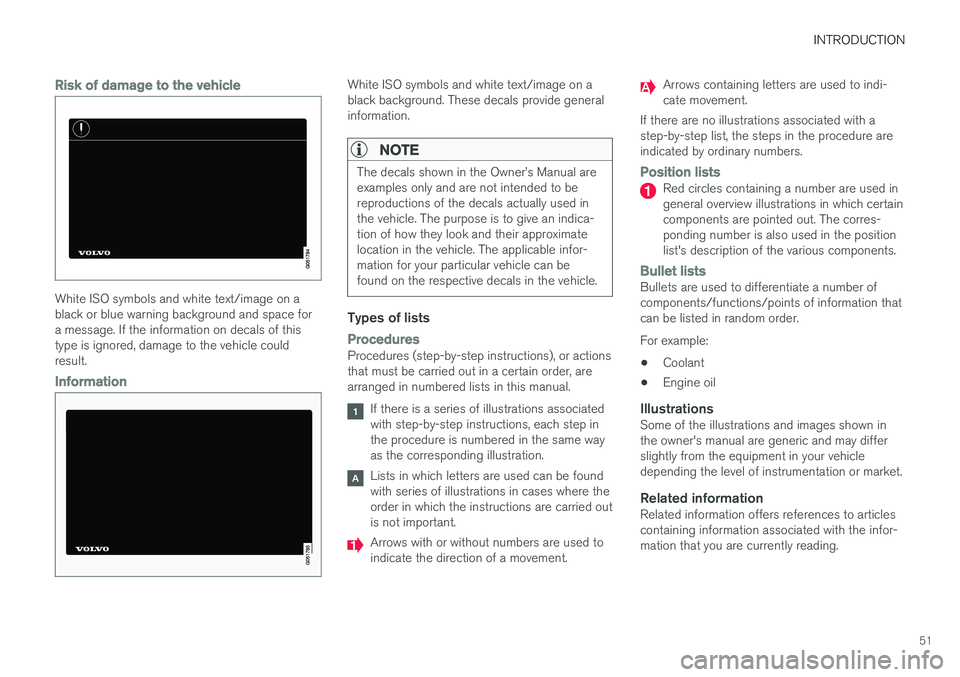
INTRODUCTION
51
Risk of damage to the vehicle
White ISO symbols and white text/image on a black or blue warning background and space fora message. If the information on decals of thistype is ignored, damage to the vehicle couldresult.
Information
White ISO symbols and white text/image on a black background. These decals provide generalinformation.
NOTE
The decals shown in the Owner
Page 54 of 570
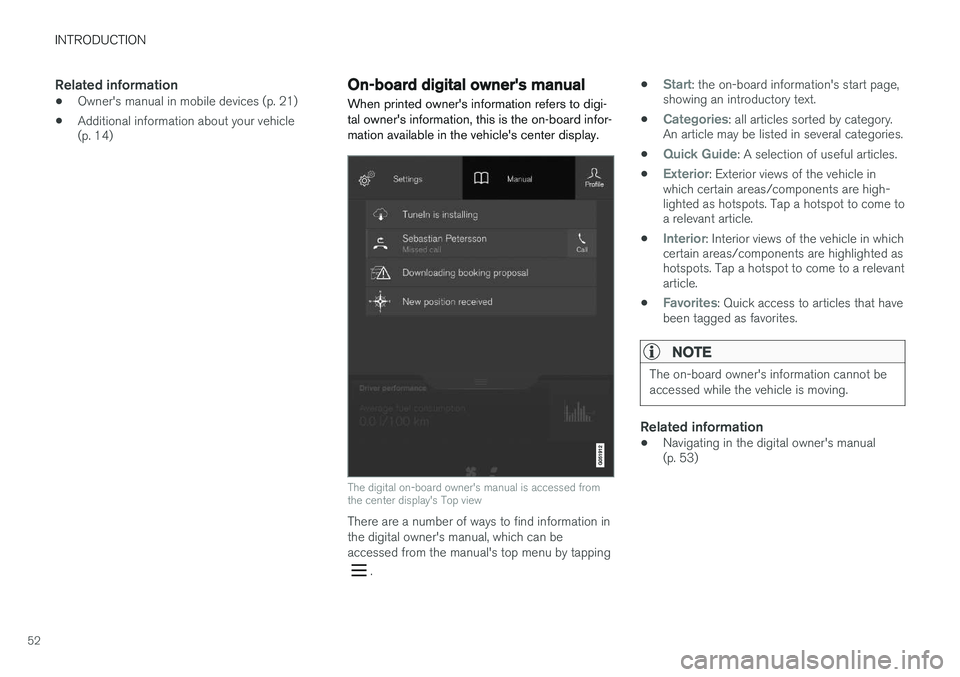
INTRODUCTION
52
Related information
•Owner's manual in mobile devices (p. 21)
• Additional information about your vehicle (p. 14)
On-board digital owner's manual
When printed owner's information refers to digi- tal owner's information, this is the on-board infor-mation available in the vehicle's center display.
The digital on-board owner's manual is accessed from the center display's Top view
There are a number of ways to find information in the digital owner's manual, which can beaccessed from the manual's top menu by tapping
. •
Start: the on-board information's start page,
showing an introductory text.
•
Categories: all articles sorted by category.
An article may be listed in several categories.
•
Quick Guide: A selection of useful articles.
•
Exterior: Exterior views of the vehicle in
which certain areas/components are high- lighted as hotspots. Tap a hotspot to come toa relevant article.
•
Interior: Interior views of the vehicle in which
certain areas/components are highlighted as hotspots. Tap a hotspot to come to a relevantarticle.
•
Favorites: Quick access to articles that have
been tagged as favorites.
NOTE
The on-board owner's information cannot be accessed while the vehicle is moving.
Related information
• Navigating in the digital owner's manual (p. 53)
Page 55 of 570
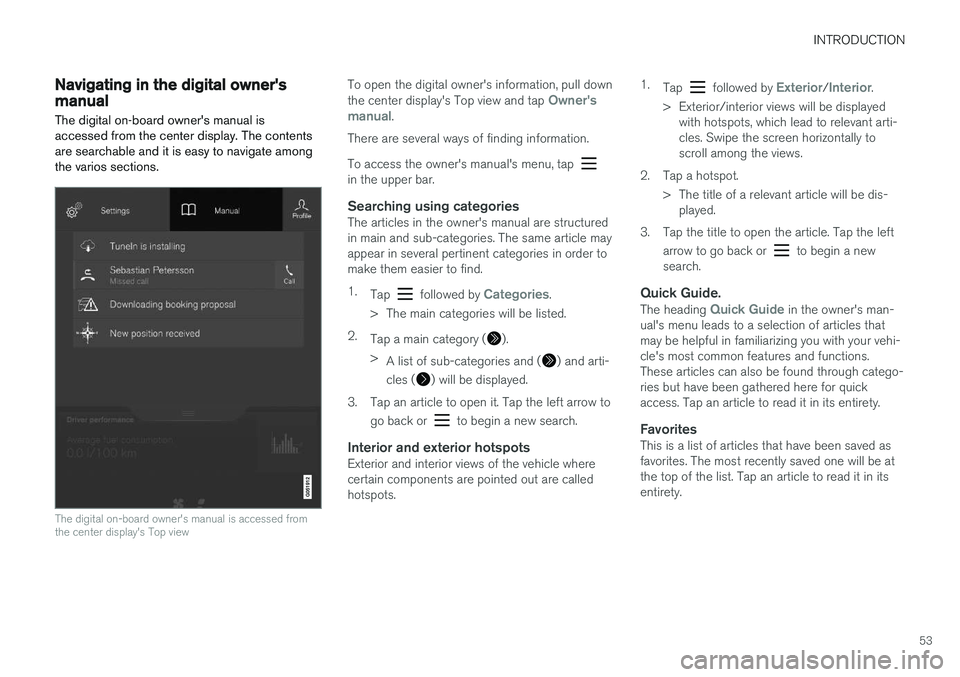
INTRODUCTION
53
Navigating in the digital owner's manual The digital on-board owner's manual is accessed from the center display. The contentsare searchable and it is easy to navigate amongthe varios sections.
The digital on-board owner's manual is accessed from the center display's Top view
To open the digital owner's information, pull down the center display's Top view and tap Owner's
manual.
There are several ways of finding information. To access the owner's manual's menu, tap
in the upper bar.
Searching using categoriesThe articles in the owner's manual are structured in main and sub-categories. The same article mayappear in several pertinent categories in order tomake them easier to find. 1. Tap
followed by Categories.
> The main categories will be listed.
2. Tap a main category (
).
> A list of sub-categories and (
) and arti-
cles (
) will be displayed.
3. Tap an article to open it. Tap the left arrow to go back or
to begin a new search.
Interior and exterior hotspotsExterior and interior views of the vehicle where certain components are pointed out are calledhotspots. 1.
Tap
followed by Exterior/Interior.
> Exterior/interior views will be displayed with hotspots, which lead to relevant arti- cles. Swipe the screen horizontally toscroll among the views.
2. Tap a hotspot. > The title of a relevant article will be dis-played.
3. Tap the title to open the article. Tap the left arrow to go back or
to begin a new
search.
Quick Guide.
The heading Quick Guide in the owner's man-
ual's menu leads to a selection of articles that may be helpful in familiarizing you with your vehi-cle's most common features and functions.These articles can also be found through catego-ries but have been gathered here for quickaccess. Tap an article to read it in its entirety.
FavoritesThis is a list of articles that have been saved asfavorites. The most recently saved one will be atthe top of the list. Tap an article to read it in itsentirety.
Page 56 of 570

INTRODUCTION
* Option/accessory, for more information, see Introduction.
54
Saving/deleting favoritesSave an article as a favorite by tapping the star (
) at the upper right when an article is open.
The star symbol will be filled in (
) when its arti-
cle has been saved as a favorite. To delete a favorite, tap its star again.
Using the search function1. Tap the magnifying glass icon () in the
owner's manual's upper menu. A keyboard will appear at the bottom of the screen.
2. Enter a word, e.g., "seat belt." > Suggested articles will be displayed asmore characters are entered.
3. Confirm by tapping the article. To leave search mode tap the up-arrow next to thesearch box.
Related information
• On-board digital owner's manual (p. 52)
• Using the center display keyboard (p. 32)
Glass
Laminated glass
The windshield and panoramic roof
* are made of
laminated glass, which is reinforced to help pre- vent break-ins and to provide additional sound-proofing. Laminated glass is optional for theother side windows.
Laminated glass symbol 6
Related information
•
Laminated panoramic roof
* (p. 101)
• Power windows (p. 104)
• Defrosting windows and mirrors (p. 187)
• Using sun shades (p. 106)
• Rearview mirror (p. 105)
• Power windows (p. 104)
• Head-up display (HUD)
* (p. 117)
• Activating/deactivating the rain sensor (p. 155)
• Windshield and headlight washers (p. 156)
• Tailgate window wiper and washer (p. 157)
Technician certification
In addition to Volvo factory training, Volvo sup- ports certification by the National Institute forAutomotive Service Excellence (A.S.E.).
Certified technicians have demonstrated a high degree of competence in specific areas. Besidespassing exams, each technician must also haveworked in the field for two or more years before acertificate is issued. These professional techni-cians are best able to analyze vehicle problemsand perform the necessary maintenance proce-dures to keep your Volvo at peak operating con-dition.
6 This symbol is not shown on the windshield or panoramic roof.
Page 57 of 570

S A F E T Y
Page 58 of 570

SAFETY
56
General safety information The vehicle is equipped with a number of safety systems for the driver and passengers.
Warning symbol in the instrument panelThe warning symbol in the instrument panel illuminates when the ignition is in mode II or higher. It will go out after
approx. 6 seconds if no faults are
detected in the airbag system.
WARNING
• If the SRS warning light stays on after the engine has started or if it illuminateswhile you are driving, have the vehicleinspected by a trained and qualified Volvoservice technician as soon as possible.
• Never try to repair any component or partof the SRS yourself. Any interference inthe system could cause malfunction andserious injury. All work on these systemsshould be performed by a trained andqualified Volvo service technician.
Related information
• Safety during pregnancy (p. 62)
• Seat belts (p. 58)
• Safety systems (p. 83)
• Airbag system (p. 83)
Occupant safety Safety is Volvo's cornerstone.
Volvo's concern for safetyOur concern for safety dates back to 1927 when the first Volvo rolled off the production line.Three-point seat belts (a Volvo invention), safetycages, and energy-absorbing impact zones weredesigned into Volvo vehicles long before it wasfashionable or required by government regulation. We will not compromise our commitment to safety. We continue to seek out new safety fea-tures and to refine those already in our vehicles.You can help. We would appreciate hearing yoursuggestions about improving automobile safety.We also want to know if you ever have a safetyconcern with your vehicle. Call us in the U.S. at:1-800-458-1552 or in Canada at:1-800-663-8255.
Occupant safety remindersHow safely you drive doesn't depend on how old you are but rather on:
• How well you see.
• Your ability to concentrate.
• How quickly you make decisions under stress to avoid an accident.
The following suggestions are intended to help you cope with the ever changing traffic environ-ment. •
Never drink and drive.
• If you are taking any medication, consult your physician about its potential effects on yourdriving abilities.
• Take a driver-retraining course.
• Have your eyes checked regularly.
• Keep your windshield and headlights clean.
• Replace wiper blades when they start toleave streaks.
• Take into account the traffic, road, andweather conditions, particularly with regard tostopping distance.
• Never send text messages while driving.
• Refrain from using or minimize the use of acell phone while driving.
Related information
• Recall information (p. 58)
• Reporting safety defects (p. 57)
Page 59 of 570
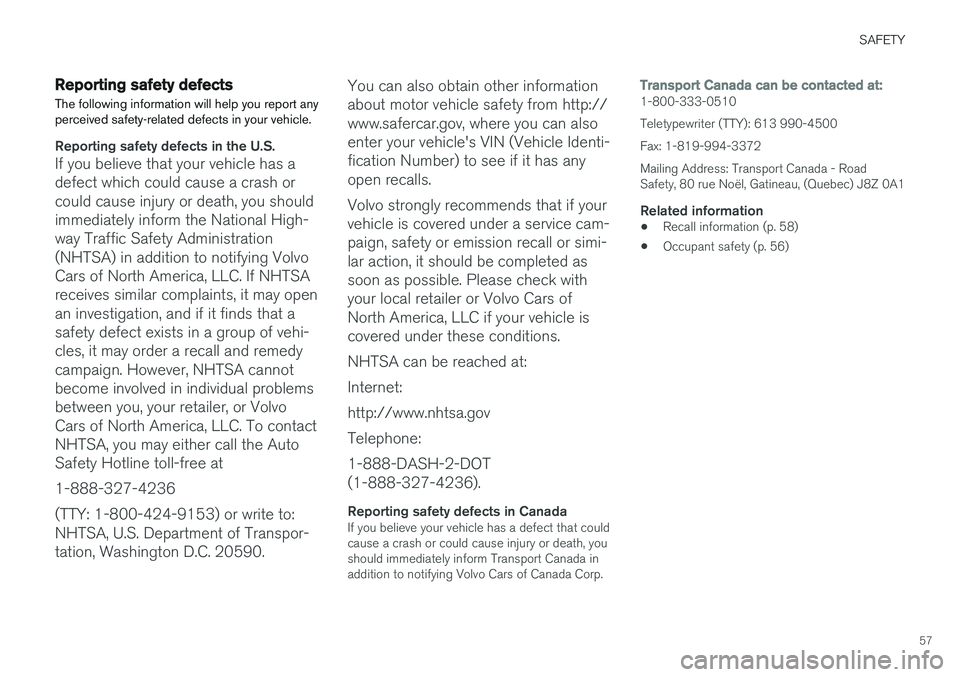
SAFETY
57
Reporting safety defects
The following information will help you report any perceived safety-related defects in your vehicle.
Reporting safety defects in the U.S.
If you believe that your vehicle has a defect which could cause a crash orcould cause injury or death, you shouldimmediately inform the National High-way Traffic Safety Administration(NHTSA) in addition to notifying VolvoCars of North America, LLC. If NHTSAreceives similar complaints, it may openan investigation, and if it finds that asafety defect exists in a group of vehi-cles, it may order a recall and remedycampaign. However, NHTSA cannotbecome involved in individual problemsbetween you, your retailer, or VolvoCars of North America, LLC. To contactNHTSA, you may either call the AutoSafety Hotline toll-free at 1-888-327-4236(TTY: 1-800-424-9153) or write to: NHTSA, U.S. Department of Transpor-tation, Washington D.C. 20590. You can also obtain other informationabout motor vehicle safety from http://www.safercar.gov, where you can alsoenter your vehicle's VIN (Vehicle Identi-fication Number) to see if it has anyopen recalls. Volvo strongly recommends that if your vehicle is covered under a service cam-paign, safety or emission recall or simi-lar action, it should be completed assoon as possible. Please check withyour local retailer or Volvo Cars ofNorth America, LLC if your vehicle iscovered under these conditions. NHTSA can be reached at:Internet:http://www.nhtsa.govTelephone:1-888-DASH-2-DOT (1-888-327-4236).
Reporting safety defects in CanadaIf you believe your vehicle has a defect that could cause a crash or could cause injury or death, youshould immediately inform Transport Canada inaddition to notifying Volvo Cars of Canada Corp.
Transport Canada can be contacted at:1-800-333-0510 Teletypewriter (TTY): 613 990-4500Fax: 1-819-994-3372Mailing Address: Transport Canada - Road Safety, 80 rue Noël, Gatineau, (Quebec) J8Z 0A1
Related information
•
Recall information (p. 58)
• Occupant safety (p. 56)
Page 60 of 570
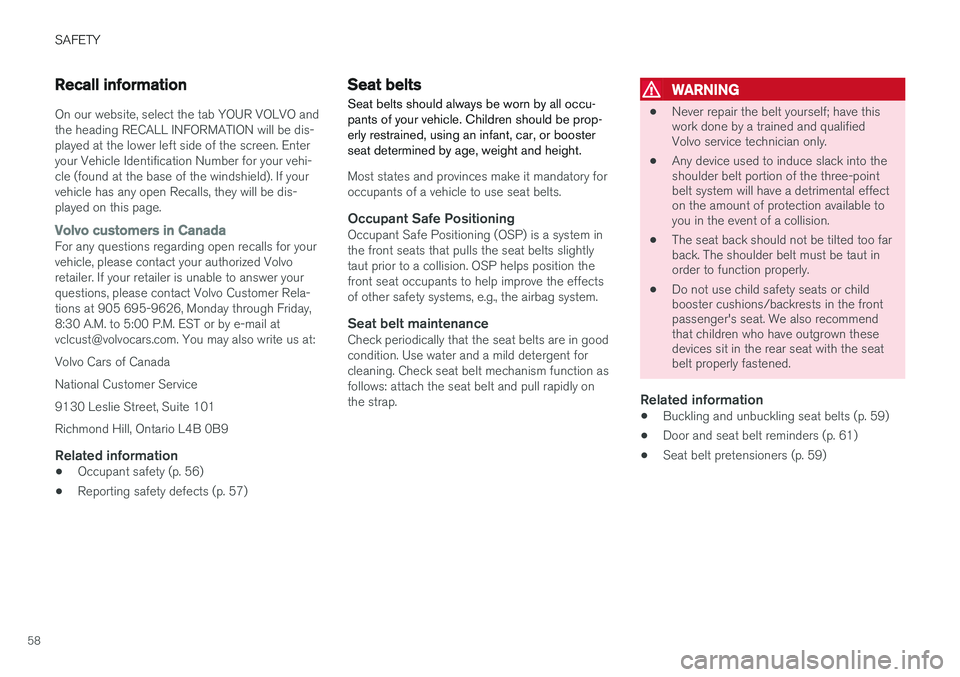
SAFETY
58
Recall information
On our website, select the tab YOUR VOLVO and the heading RECALL INFORMATION will be dis-played at the lower left side of the screen. Enteryour Vehicle Identification Number for your vehi-cle (found at the base of the windshield). If yourvehicle has any open Recalls, they will be dis-played on this page.
Volvo customers in CanadaFor any questions regarding open recalls for your vehicle, please contact your authorized Volvoretailer. If your retailer is unable to answer yourquestions, please contact Volvo Customer Rela-tions at 905 695-9626, Monday through Friday,8:30 A.M. to 5:00 P.M. EST or by e-mail [email protected]. You may also write us at: Volvo Cars of CanadaNational Customer Service9130 Leslie Street, Suite 101Richmond Hill, Ontario L4B 0B9
Related information
•Occupant safety (p. 56)
• Reporting safety defects (p. 57)
Seat belts
Seat belts should always be worn by all occu- pants of your vehicle. Children should be prop-erly restrained, using an infant, car, or boosterseat determined by age, weight and height.
Most states and provinces make it mandatory for occupants of a vehicle to use seat belts.
Occupant Safe PositioningOccupant Safe Positioning (OSP) is a system inthe front seats that pulls the seat belts slightlytaut prior to a collision. OSP helps position thefront seat occupants to help improve the effectsof other safety systems, e.g., the airbag system.
Seat belt maintenanceCheck periodically that the seat belts are in goodcondition. Use water and a mild detergent forcleaning. Check seat belt mechanism function asfollows: attach the seat belt and pull rapidly onthe strap.
WARNING
• Never repair the belt yourself; have this work done by a trained and qualifiedVolvo service technician only.
• Any device used to induce slack into theshoulder belt portion of the three-pointbelt system will have a detrimental effecton the amount of protection available toyou in the event of a collision.
• The seat back should not be tilted too farback. The shoulder belt must be taut inorder to function properly.
• Do not use child safety seats or childbooster cushions/backrests in the frontpassenger's seat. We also recommendthat children who have outgrown thesedevices sit in the rear seat with the seatbelt properly fastened.
Related information
• Buckling and unbuckling seat belts (p. 59)
• Door and seat belt reminders (p. 61)
• Seat belt pretensioners (p. 59)